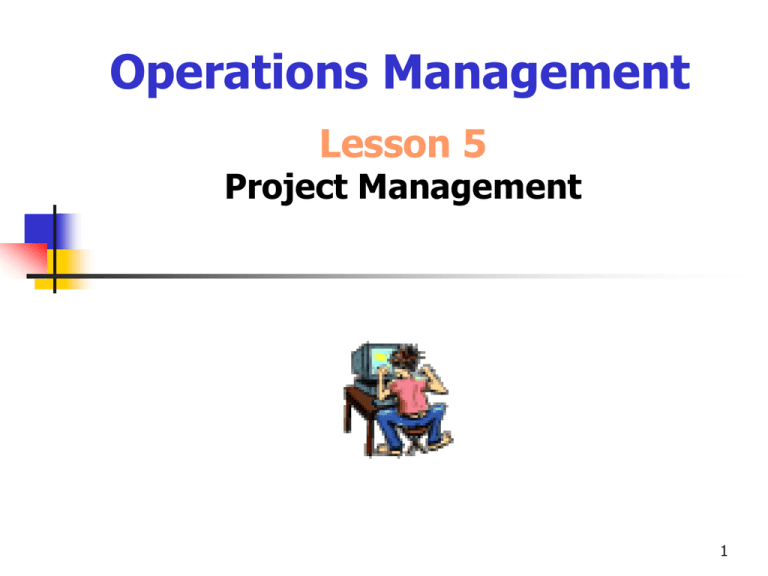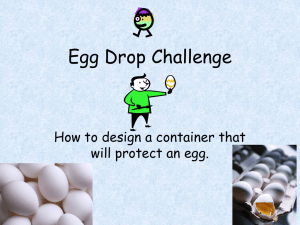Project Management
advertisement

Operations Management Lesson 5 Project Management 1 What you will learn in this unit: Project Life Cycle Project Planning Tools The Roles of Project Managers Key Success Factors 2 What is a project? A project is a set of activities, which has a defined start point and a defined end state, that pursues a defined goal and that uses a defined set of resources. Project management is the process of managing the activities within a project by planning the work, executing it and coordinating the contribution of the staff and organizations who have an interest in the project. An AIDS information campaign Designing an aircraft Constructing petronas twin tower Installing a new information system Project Management Applications What is a project? Any endeavor with objectives With multiple activities With defined precedent relationships With a specific time period for completion Examples? A major event like a wedding Any construction project Designing a political campaign 4 Five Project Life Cycle Phases Conception: identify the need Feasibility analysis or study: costs benefits, and risks Planning: who, how long, what to do? Execution: doing the project Termination: ending the project 5 Network Planning Techniques Program Evaluation & Review Technique (PERT): Developed to manage the Polaris missile project Many tasks pushed the boundaries of science & engineering (tasks’ duration = probabilistic) Critical Path Method (CPM): Developed to coordinate maintenance projects in the chemical industry A complex undertaking, but individual tasks are routine (tasks’ duration = deterministic) 6 Both PERT and CPM Graphically display the precedence relationships & sequence of activities Estimate the project’s duration Identify critical activities that cannot be delayed without delaying the project Estimate the amount of slack associated with non-critical activities 7 Some Network Definitions All activities on the critical path have zero slack Slack defines how long non-critical activities can be delayed without delaying the project Slack = the activity’s late finish minus its early finish (or its late start minus its early start) Earliest Start (ES) = the earliest finish of the immediately preceding activity Earliest Finish (EF) = is the ES plus the activity time Latest Start (LS) and Latest Finish (LF) depend on whether or not the activity is on the critical path 8 Gantt Chart is used for project scheduling; it involves multiple dimensions in assisting for planning. It’s a simple and visual oriented planning method. 9 Breakfast in bed project Purpose – to make breakfast in bed End result – breakfast in bed of boiled egg, toast & orange juice Success criteria – minimum staff resources & time; high quality (egg freshly boiled, toast warm etc.) Scope – project starts in kitchen at 6am and finishes in bedroom; needs one operator and normal equipment 10 A work breakdown structure Serve breakfast in bed Type title here produce glass of orange juice Obtain juice obtain glass Produce boiled egg in egg cup produce boiled egg Obtain egg Obtain water obtain egg cup Produce buttered toast Produce toast obtain butter Arrange tray Obtain plates and cutlery Obtain tray obtain bread 11 Breakfast in bed project Task ID a b c d e f g h I Activity Butter toast Pour orange juice Boil egg Slice bread Fill pan with water Bring water to boil Toast bread Take tray to bedroom Fetch tray etc Effort (Operatve mnutes) 1 1 0 1 1 0 0 1 1 Duration (Mins) 1 1 4 1 1 3 2 1 1 12 Breakfast in bed project Task ID a b c d e f g h I Activity Butter toast Pour orange juice Boil egg Slice bread Fill pan with water Bring water to boil Toast bread Take tray to bedroom Fetch tray etc Predecessors d,g e,f e d a,b,c,d,e,f,g,I - 13 Network diagrams Activity reference a An Activity 1 Activity duration 14 Network diagrams An event Event number 1 Earliest event time Latest event time 15 Project Slack If there is a difference between the earliest and latest event time this is known as the slack on that event If the earliest and latest event time are equal, this event lies on the critical path 16 Gantt Charts Activities requiring operator time 1 2 3 4 5 6 7 8 9 Orange Bread Water Toast Boil water Butter Boil egg Bedroom Tray Operators required 4 3 2 1 17 Gantt Charts Activities requiring operator time 1 2 3 4 5 6 7 8 9 Orange Bread Water Toast Boil water Butter Boil egg Bedroom Tray Operators required 4 3 2 1 18 Gantt Charts Activities requiring operator time 1 2 3 4 5 6 7 8 9 Orange Bread Water Boil water Toast Boil egg Butter Bedroom Tray Operators required 4 3 2 1 19 Successful Project management The following factors are particularly important: Clearly defined goals Competent project manager Top-management support Competent project members Sufficient resource allocation Adequate communications channels Control mechanisms Feedback capabilities Responsiveness to client Trouble shooting mechanisms Project staff continuity 20








